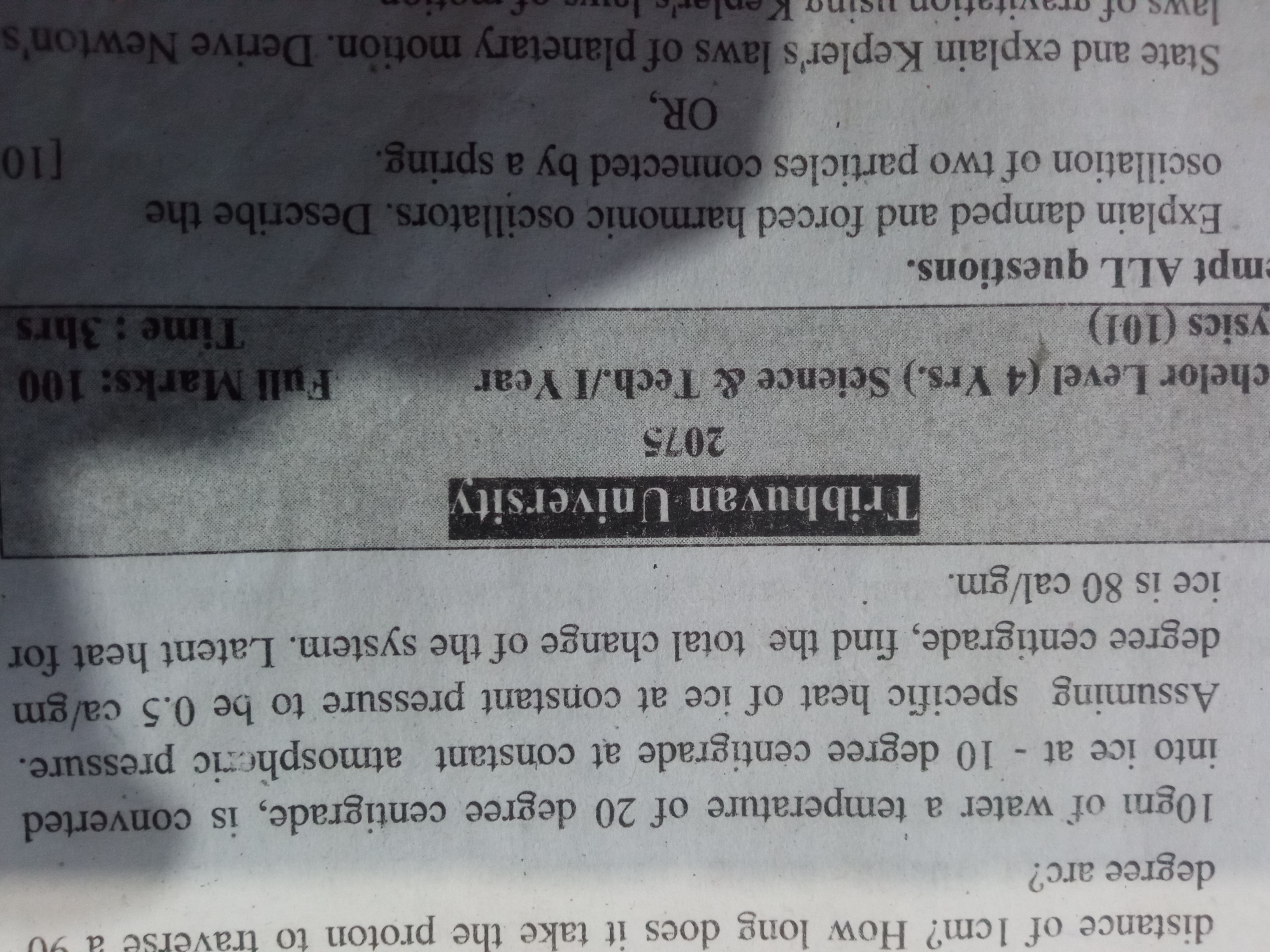Several physics problems ranging from electromagnetism and thermodynamics, including the calculation of the time it takes for a proton to traverse a 90 degree arc, finding the tota... Several physics problems ranging from electromagnetism and thermodynamics, including the calculation of the time it takes for a proton to traverse a 90 degree arc, finding the total heat change in a water to ice conversion, explaining harmonic oscillators, describing oscillations of connected particles, stating and explaining Kepler's laws, and deriving Newton's laws of motion.

Understand the Problem
The image presents several physics problems likely from an exam paper. These include calculating the time for a proton to travel a given arc, determining the total heat change in a system involving water freezing to ice, explaining harmonic oscillators, describing oscillations of connected particles, stating and explaining Kepler's laws, and deriving Newton's laws of motion.
Answer
1. $t \approx 1.57 \times 10^{-6} \text{ s}$ (assuming $v = 10^6 \text{ cm/s}$) 2. $Q = -1050 \text{ cal}$
Answer for screen readers
- Time for proton to traverse the arc (assuming $v = 10^6 \text{ cm/s}$): $t \approx 1.57 \times 10^{-6} \text{ s}$
- Total heat change: $Q = -1050 \text{ cal}$
Steps to Solve
Here are the steps to solve the two problems presented in the image:
Problem 1: Proton Traveling an Arc
-
Calculate the circumference of the circle: Given the radius $ r = 1 \text{ cm} $, the circumference $C$ is calculated using the formula: $ C = 2 \pi r $. Substituting $ r = 1 \text{ cm} $, we get $ C = 2 \pi \text{ cm} $.
-
Determine the arc length: The proton traverses a 90-degree arc, which is $ \frac{90}{360} = \frac{1}{4} $ of the full circle. So, the arc length $s$ is: $ s = \frac{1}{4} \times C = \frac{1}{4} \times 2 \pi \text{ cm} = \frac{\pi}{2} \text{ cm} $.
-
Estimate the speed of the proton: The problem is missing critical information: the proton's speed or kinetic energy. Without this, it's impossible to calculate the travel time. I will assume a hypothetical speed of $v = 10^6 \text{ cm/s}$
-
Calculate the traversal time: Time $t$ is distance $s$ divided by speed $v$: $ t = \frac{s}{v} $. Using $ s = \frac{\pi}{2} \text{ cm} $ and the assumed $ v = 10^6 \text{ cm/s} $, we get: $ t = \frac{\pi / 2}{10^6} \text{ s} = \frac{\pi}{2 \times 10^6} \text{ s} \approx 1.57 \times 10^{-6} \text{ s} $.
Problem 2: Water to Ice Conversion
-
Cooling water from 20°C to 0°C: The heat released $Q_1$ is given by $ Q_1 = m c \Delta T $, where $ m = 10 \text{ gm} $, $ c = 1 \text{ cal/gm}^\circ\text{C} $ (specific heat of water), and $ \Delta T = 20^\circ\text{C} $. $ Q_1 = 10 \text{ gm} \times 1 \text{ cal/gm}^\circ\text{C} \times 20^\circ\text{C} = 200 \text{ cal} $. Since heat is released, $Q_1 = -200 \text{ cal}$.
-
Freezing water at 0°C to ice at 0°C: The heat released $Q_2$ during the phase change (latent heat) is $ Q_2 = -mL $, where $ L = 80 \text{ cal/gm} $. Thus, $ Q_2 = -10 \text{ gm} \times 80 \text{ cal/gm} = -800 \text{ cal} $.
-
Cooling ice from 0°C to -10°C: The heat released $Q_3$ is given by $ Q_3 = m c_{ice} \Delta T $, where $ c_{ice} = 0.5 \text{ cal/gm}^\circ\text{C} $ and $ \Delta T = 10^\circ\text{C} $. $ Q_3 = 10 \text{ gm} \times 0.5 \text{ cal/gm}^\circ\text{C} \times 10^\circ\text{C} = 50 \text{ cal} $. Since heat is released, $Q_3 = -50 \text{ cal}$.
-
Total heat change: The total heat change $Q$ is the sum of $Q_1$, $Q_2$, and $Q_3$: $ Q = Q_1 + Q_2 + Q_3 = -200 \text{ cal} - 800 \text{ cal} - 50 \text{ cal} = -1050 \text{ cal} $.
- Time for proton to traverse the arc (assuming $v = 10^6 \text{ cm/s}$): $t \approx 1.57 \times 10^{-6} \text{ s}$
- Total heat change: $Q = -1050 \text{ cal}$
More Information
The negative sign in the heat change indicates that the system releases heat during the process of converting water at 20°C to ice at -10°C.
Tips
- For the proton problem, a common mistake is forgetting to convert the angle from degrees to radians or not accounting for the fraction of the circle the proton traverses. Another significant oversight is proceeding without a given or assumed velocity.
- For the heat transfer problem, common mistakes include using the wrong specific heat values (water vs. ice), forgetting the negative sign for heat released, or not including all three stages (cooling water, freezing, cooling ice).
AI-generated content may contain errors. Please verify critical information